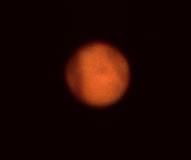
The Martian surface markings are merely variations in the reflectivity, or albedo, of the Martian soil. The surface markings that we see with a typical amateur size instrument have little to do with the actual surface topography. The brighter areas are deserts covered by fine dust. The darker areas are believed to be bare rock, rubble, or coarse sand. As dust storms arise and blow dust around the surface, the shape, size, and prominence of the surface markings may change. Mars is a harsh, rugged, dry planet, and is colder than Earth.
In this photo, the South Pole of Mars is on the left. The dark area on the left is Mare Sirenum and Mare Cimmerium. The North Pole of Mars is at the upper right. The dark spot near the center of the planet is Stymphalius Lacus.
This photo was taken with a Takahashi FS-128 refractor. Eyepiece projections was used with a 5mm eyepiece. The film was 35mm Kodak Elitechrome 100 slide film. A Nikon F-2 camera body was employed. The optical tude assembly was carried on a Takahashi NJP mount.
Constellation: Virgo
RA: 14h 14m 28.1s Dec: -11d 56' 08"
April 21, 1999
Photo by Sid Leach
Iola, Texas
Recent Images.
Complete list of images.
Description of equipment used to acquire images.
Home
Feedback and comments should go to Sid